How To Repair Lightning Connector

-
Power off your iPhone before beginning disassembly.
-
Remove the two 3.four mm pentalobe screws on the bottom edge of the iPhone.

-
Use a hairdryer or gear up an iOpener and use it to the lower edge of the iPhone for well-nigh a infinitesimal in order to soften upward the adhesive underneath.




-
Attach a suction loving cup to the lower half of the brandish assembly, only above the dwelling house button.



-
Pull upward on the suction cup to create a small gap between the display assembly and the rear instance.
-
Insert the flat stop of a spudger into the gap.



-
Slide the spudger to the left along the lower edge of the iPhone.
-
Twist the spudger to widen the gap between the display and rear case.



-
Slide the spudger up the left side of the iPhone, starting at the lower edge and moving towards the book control buttons and silent switch.



-
Insert the flat edge of a spudger into the bottom right corner of the device.
-
Twist the spudger to widen the gap between the display assembly and the rear case.
-
Slide the flat end of the spudger upwards the right side of the telephone to interruption up the adhesive holding the display in place.




-
Pull up on the suction cup to elevator up the display and open the iPhone.

-
Pull up on the modest nub on the suction cup to remove it from the front console.




-
Slide an opening pick along the meridian edge of the iPhone, between the rear instance and front panel, to break up the remaining adhesive property the screen in place.



-
Pull the display assembly slightly away from the elevation edge of the phone to undo the clips holding it to the rear instance.
-
Open the iPhone by swinging the brandish up from the left side, similar the back cover of a volume.
-
Remove iv tri-point Y000 screws securing the lower connector bracket, of the following lengths:
-
Iii 1.2 mm screws
-
Ane 2.4 mm screw

-
Remove the lower connector bracket.



-
Use the indicate of a spudger to lift the bombardment connector out of its socket on the logic board.



-
Apply a spudger or a fingernail to disconnect the ii lower display connectors by prying them straight up from their sockets on the logic board.



-
Remove the ii 1.three mm Phillips #000 screws securing the bracket over the forepart console sensor associates connector.




-
Disconnect the front console sensor associates connector from its socket on the logic board.

-
Remove the display assembly.

-
Remove the two 1.9 mm Phillips screws securing the barometric vent to the rear example.




-
Remove the vent.




-
Use the flat end of a spudger to disconnect the Taptic Engine connector from its socket on the logic lath.

-
Remove the three one.6 mm Phillips screws securing the Taptic Engine to the rear instance.




-
Remove the Taptic Engine.

-
Remove the Phillips screw securing the Wi-Fi diversity antenna to the rear instance:
-
One 3.2 mm spiral

-
Remove the following three Phillips screws securing the speaker to the rear example:
-
Two i.three mm screws
-
Ane ii.0 mm screw



-
Use the point of a spudger to lift the two antenna cable connectors up off of the sockets on the logic board.




-
Employ tweezers to derout the antenna cables from their bracket on the logic lath.




-
Use tweezers to remove the antenna cables from the prune on the speaker.




-
Utilize the tip of a spudger to slide the speaker assembly towards the logic board and off of the rear case.

-
Remove the speaker.


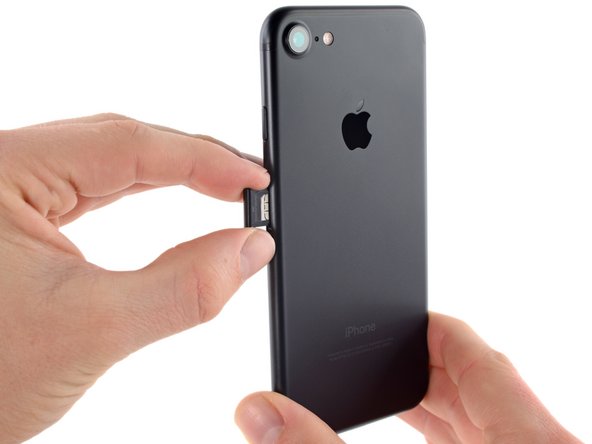
-
Insert a SIM card eject tool or a paperclip into the small pigsty in the SIM card tray.
-
Printing to eject the tray.
-
Remove the SIM card tray assembly from the iPhone.




-
Apply the flat end of a spudger to disconnect the rear-facing camera connector.




-
Remove the following Phillips screws securing the rear camera subclass to the rear case:
-
1 i.3 mm screw
-
Ane 2.5 mm screw

-
Remove the bracket.




-
Use the pointed end of a spudger to pry upwards and disconnect the antenna double-decker connector, only left of the rear camera module.

-
Remove the 2 one.two mm tri-point screws securing the upper cablevision bracket.




-
Remove the upper cable bracket.




-
Use the flat end of a spudger to disconnect the upper cable connector.




-
Remove the iv Phillips screws securing the Wi-Fi antenna:
-
Three i.2 mm screws
-
One 1.vii mm screw




-
Remove the height left antenna.

-
Remove the following Phillips screws:
-
One one.iii mm screw
-
One 2.2 mm screw




-
Remove the bracket.
-
Remove the 2.ii mm standoff screw from the grounding subclass.




-
Use tweezers to gently bend the logic board grounding bracket out of the way.




-
Use the point of a spudger to disconnect the lower cablevision connector.

-
Remove the following screws:
-
One ane.4 mm Phillips spiral
-
Iii ii.2 mm standoff screws
-
In a pinch, a small-scale flathead screwdriver will exercise the job—simply use extra circumspection to ensure it doesn't slip and harm surrounding components.




-
Use the betoken of a spudger to move the SIM carte eject plunger out of the logic lath's way.

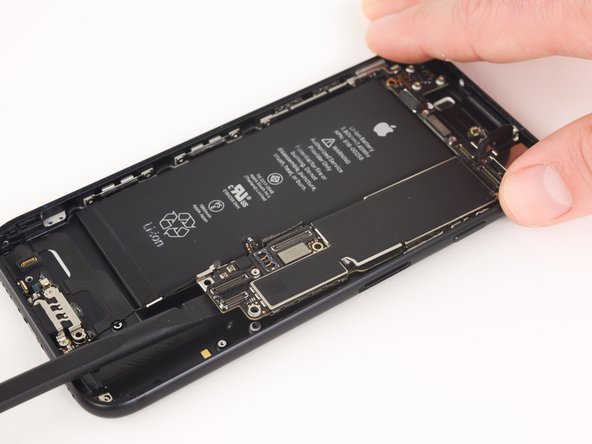


-
Use the flat finish of a spudger to gently lift the battery connector end of the logic board upwards.



-
Lift the battery connector end of the logic lath and pull it up and out of the rear case.

-
Remove the 2.nine mm Phillips screw from the lightning connector.




-
Remove the leap contact from the lightning connector.

-
Remove the two 1.6 mm Phillips screws securing the lightning connector cablevision in place.


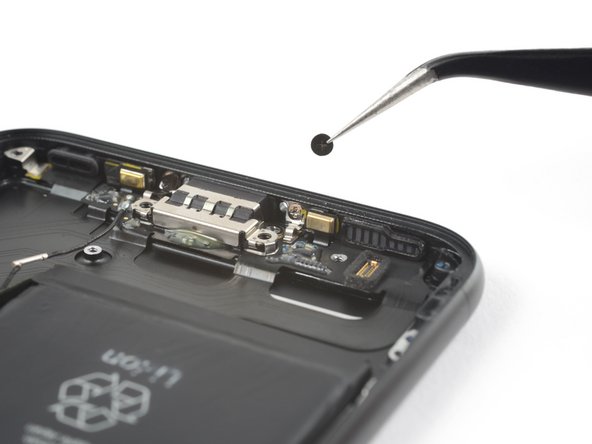
-
Remove the two stickers roofing the screws that secure the lightning connector to the bottom of the rear case.

-
Remove the ii i.3 mm Phillips screws from the rear case.




-
Utilize the pointed end of a spudger to split the two microphones from the bottom of the rear case.

-
Use a hairdryer or reheat your iOpener to heat the lower edge of the phone.
-
Look for well-nigh a minute, allowing the agglutinative to warm up before proceeding to the next stride.

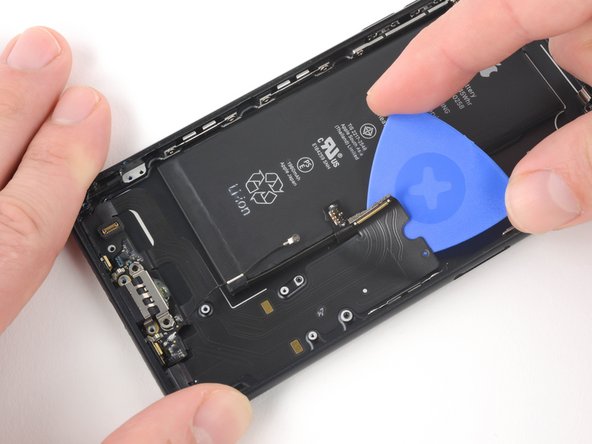
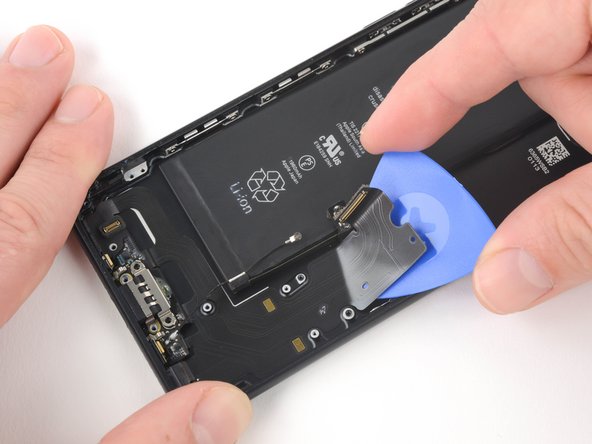
-
Starting from the middle of the phone, slide an opening pick underneath the lightning connector to separate information technology from the rear instance.



-
Continue to slide the pick towards the lightning connector to further divide the assembly from the rear case.

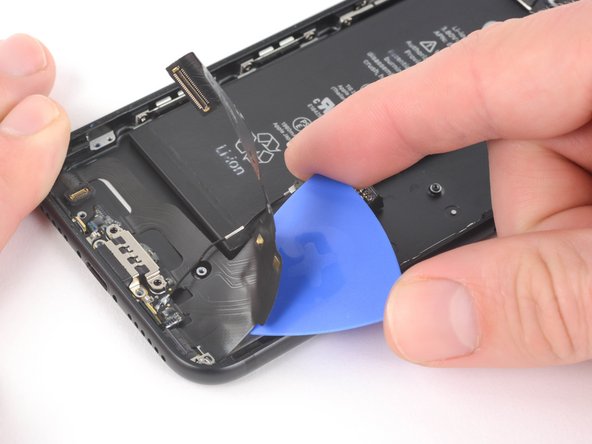


-
Continue to slide the selection underneath the lightning connecter assembly.
-
Terminate sliding the pick once it passes the battery.

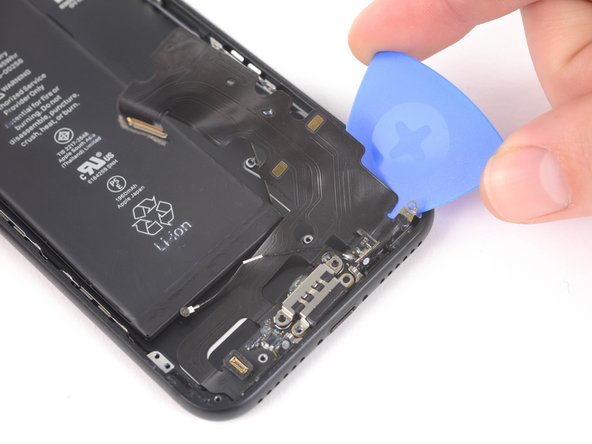
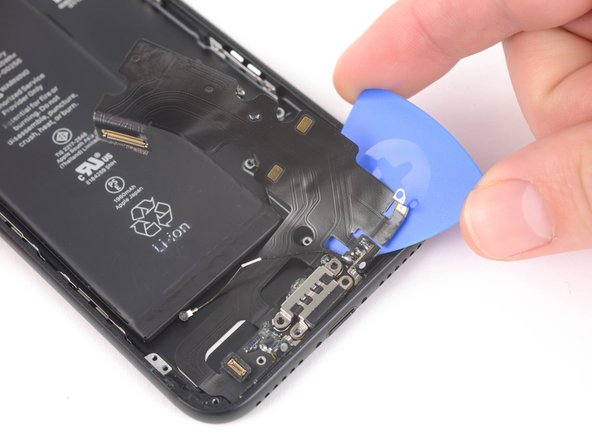
-
Starting at the corner of the phone, slide the selection underneath the assembly towards the lightning connector.
-
Terminate sliding the pick when information technology reaches the lightning connector.




-
Gently pull the lightning connector out of its hole on the rear instance.




-
Slide a choice below the lightning connector to further dissever the lightning connector assembly from the rear case.
-
Continue to slide the pick until the lightning connector assembly is no longer adhered to the rear case.



-
Remove the lightning connector assembly.
-
Use a plastic tool to scour any bits of agglutinative residue from the rear case.
-
Make sure the Lightning connector assembly is correctly positioned so that the 2 white dots on the iPhone's rear case show through the two circular cutouts in the Lightning flex cable. If they don't, the flex cablevision will remain misaligned and yous won't be able to reconnect it to its socket on the logic board.



Source: https://www.ifixit.com/Guide/iPhone+7+Lightning+Connector+Assembly+Replacement/78122
Posted by: bakerfacesoccat.blogspot.com


0 Response to "How To Repair Lightning Connector"
Post a Comment